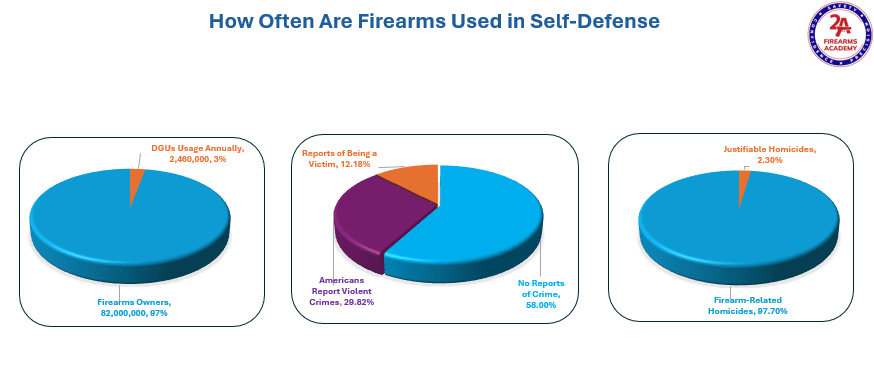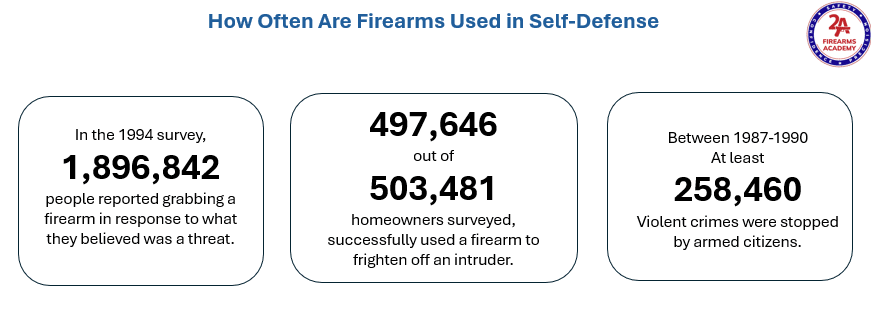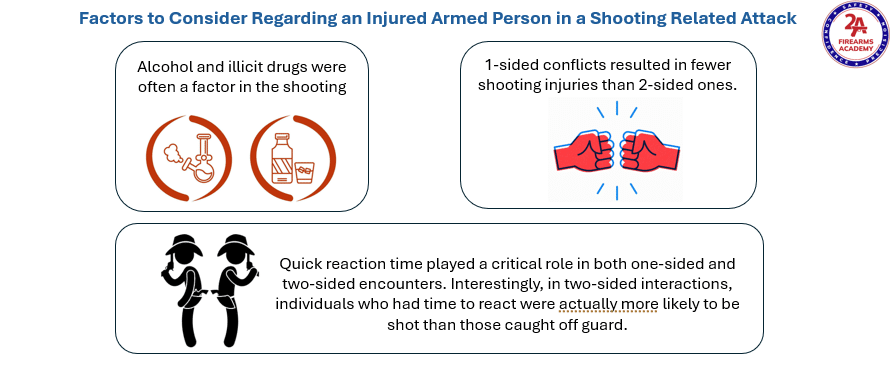Defensive Gun Use in America: How Armed Citizens Protect Themselves and Others
Understanding the Role of Defensive Firearm Use
The Second Amendment provides Americans with a constitutional safeguard: the right to keep and bear arms. But beyond constitutional theory, millions of Americans exercise this right in the most personal way—by protecting their lives and loved ones from violent crime.
One of the most debated subjects in today’s firearms discourse is how often guns are actually used in self-defense. While the numbers vary depending on how the data is collected, there’s one thing we do know: armed civilians play a real and measurable role in deterring and stopping crime in the United States.
At a Glance: Key Defensive Gun Use Figures
- Studies estimate between 60,000 and 2.5 million instances of defensive gun use each year.
- The annual average of reported DGUs is approximately 1.82 million, compared to 1.1 million reported criminal offenses.
- Around 2.07 million Americans carry firearms regularly for self-defense.
- A person is 85% more likely to defend themselves with a gun than to be fatally shot by one.
- The typical defensive shooting occurs at a distance of three yards.

How Frequently Are Guns Used to Stop a Crime?
Estimates of defensive gun use (DGU) in the U.S. vary widely—largely because different surveys define and measure it in different ways. Some research asks general questions like, “Have you ever retrieved a firearm because you felt threatened?” while others only count events with verified criminal threats.
Across decades of data collection, estimates consistently range from 60,000 to 2.5 million DGUs per year, with the most commonly cited average landing around 1.82 million. Even a high-end estimate of 4.3 million DGUs per year—based on a CNN study—represents just 2% of U.S. gun owners responding to a threat.

The Legal Landscape: How State Laws Affect Defensive Use
In states like Indiana—where Stand Your Ground and permitless carry laws are in place—armed self-defense is more legally protected. In January 2024 alone, 14 of 18 homicide cases in Indianapolis involved claims of self-defense. These ranged from break-ins to domestic assaults.
Despite some studies claiming that Stand Your Ground laws lead to more homicides, broader comparisons reveal no significant difference in murder rates between states that allow permitless carry and those that don’t. Between 2020 and 2022, U.S. homicide rates rose overall—regardless of state-level gun policies.
Notably, states that passed no-duty-to-retreat laws saw reductions in violent victimizations over time. In fact, three out of four states with Stand Your Ground laws experienced declines in violent crime after implementation.
Why Estimates Vary: Understanding the Self-Defense Data Debate
Accurate DGU counts are difficult because the term itself has no single legal or research definition. Some reports focus only on crimes where a gun was discharged; others include incidents where a firearm was simply shown or mentioned.
- The Gun Violence Archive, which relies on media reports, documented 3,165 defensive gun uses between 2014–2023—but only counts cases covered by news outlets where a shot was fired.
- The National Crime Victimization Survey (NCVS) estimates 87,000 DGUs annually, focusing on non-fatal incidents.
- Broader self-reported surveys suggest over 1 million DGUs yearly, capturing a fuller range of defensive uses—including deterrence without firing.
Concealed Carry and Defensive Use Behavior
Guns are used defensively about 1.8 million times per year, compared to 1.1–1.2 million reported crimes, suggesting that defensive use outpaces criminal use.
While 56% of firearm owners say personal protection is their primary reason for owning a gun, only 35% actually carry regularly, and just 26.5% carry concealed. Notably, 35% of gun owners said restrictive concealed carry laws discouraged them from carrying at all.
To summarize:
- 56% own guns for self-defense.
- 35% carry their firearm with some frequency.
- 26.3% (about 2.07 million people) carry concealed.
- 34.9% reported avoiding carry due to permit restrictions.
Guns Stop Crime—Here’s the Data
A review of past research shows that firearms are used frequently to halt criminal behavior:
- In a 1994 survey of 1,678 gun-owning households, 34% said they had reached for a firearm in response to a perceived threat.
- That translates to an estimated 1.89 million people retrieving a gun due to fear of harm.
- Over 500,000 respondents reported seeing an intruder; nearly the same number said they successfully scared the intruder away.
- Between 1987 and 1990 alone, at least 258,460 violent crimes were prevented by armed civilians.
Even if we consider only the most conservative estimates, at least 60,000 crimes are stopped each year by lawful gun owners.

What the FBI Says About Self-Defense Homicides
According to the FBI, defensive firearm use results in homicide in a small percentage of cases—2.3% of all homicides.
Here’s what the data shows:
- Between 1976 and 2018, the FBI recorded 28,770 justifiable homicides.
- 53% of these were carried out by civilians; 47% by law enforcement.
- 35.8% occurred during the commission of a felony.
- 15.6% involved a felon violently attacking a civilian.
It’s worth noting that many agencies do not report “justifiable homicides” separately, so these numbers are likely underestimated.

You’re More Likely to Defend With a Gun Than Be Killed by One
The numbers highlight a stark contrast: Americans are 85% more likely to use a firearm to defend themselves than to be murdered with one. From 2014 to 2018, the NCVS reported:
- 166,000 defensive gun uses during violent crimes
- 183,000 during property crimes
- During the same period, there were roughly 13,380 firearm-related homicides per year
Who Commits Gun Violence?
Between 2014 and 2018, there were approximately 1.9 million nonfatal violent crime incidents involving firearms. Of these:
- 59% were committed by strangers (around 1.14 million)
- 41% involved people known to the victim, such as acquaintances or family
In 2019:
- Out of 13,927 homicide victims, 1,372 were killed by strangers
- 6,808 victims had no known relationship with the attacker
- 85 were killed by husbands, and 28 by wives
When Defensive Gun Use Fails
A 2009 study in Philadelphia offers insight into situations where gun ownership didn’t stop an attack. It examined adults over 21 who were shot while in possession of a firearm.
Key factors included:
- Drug or alcohol use was often involved
- Two-sided altercations led to more violence than one-sided encounters
- Reaction time played a major role—ironically, those who had time to react were more likely to be shot
According to the study, gun owners were 5.45 times more likely to be shot than unarmed individuals, though outside factors like substance abuse and poverty significantly influenced the findings.

How Far Are Most Defensive Shots?
According to FBI data, defensive shootings typically happen within three yards (about 9 feet) of the assailant.
How Many Shots Are Fired?
Most defensive encounters are short. On average, only three rounds are discharged during a defensive shooting.
Final Thoughts: The Reality of Defensive Gun Use in the U.S.
While disagreements remain about the exact number of defensive gun uses, the overall message is clear: lawful gun owners use their firearms to stop crime more often than they are used in violent acts.
With millions of armed citizens across the country, it is not only plausible—but likely—that guns prevent far more harm than they cause. States with strong self-defense laws have not seen higher homicide rates, and in many cases, have experienced reduced violent crime.
Resources:
- Indianapolis Police See Rise in Self-Defense Shootings
- Analysis of ‘Stand Your Ground’ Self-defense Laws and Statewide Rates of Homicides and Firearm Homicides
- CDC Wonder Underlying Cause of Death 2018-2019
- Effects of Laws Expanding Civilian Rights to Use Deadly Force in Self-Defense on Violence and Crime: A Systematic Review
- Distance & Shots Fired
- Defensive Gun Uses
- Gun Threats & Self-Defense Gun Use
- Number of US Households
- Gun Ownership by Year
- FBI Defensive Gun Uses by Year
- FBI Justifiable Homicide Civilian/LEO
- Nonfatal Victimizations NCVS
- How Americans Protect Themselves From Crime – Gallup
- Firearms & Home Defense
- Violent Crime Reporting Stats
- Variations in FBI Reporting
- Bureau of Justice Statistics
- Office of Justice Programs

